Business and Business Environment Report: Waitrose Case Study Analysis
VerifiedAdded on 2020/06/06
|15
|4002
|121
Report
AI Summary
This report provides a comprehensive overview of business operations and environment, examining different types of organizations, including public, private, and voluntary sectors. It explores organizational functions and structures, using Waitrose as a case study to illustrate key concepts. The report delves into the relationships between organizational functions and objectives, as well as the impact of macro environmental factors, such as those analyzed through PESTLE analysis. It covers topics like inventory management, store timings, and various organizational divisions, and provides an in-depth look at Waitrose's organizational structure, linking it to its objectives of profitability and customer satisfaction. The analysis includes discussions on the size and scope of selected organizations and their legal structures, providing a holistic view of the business landscape.
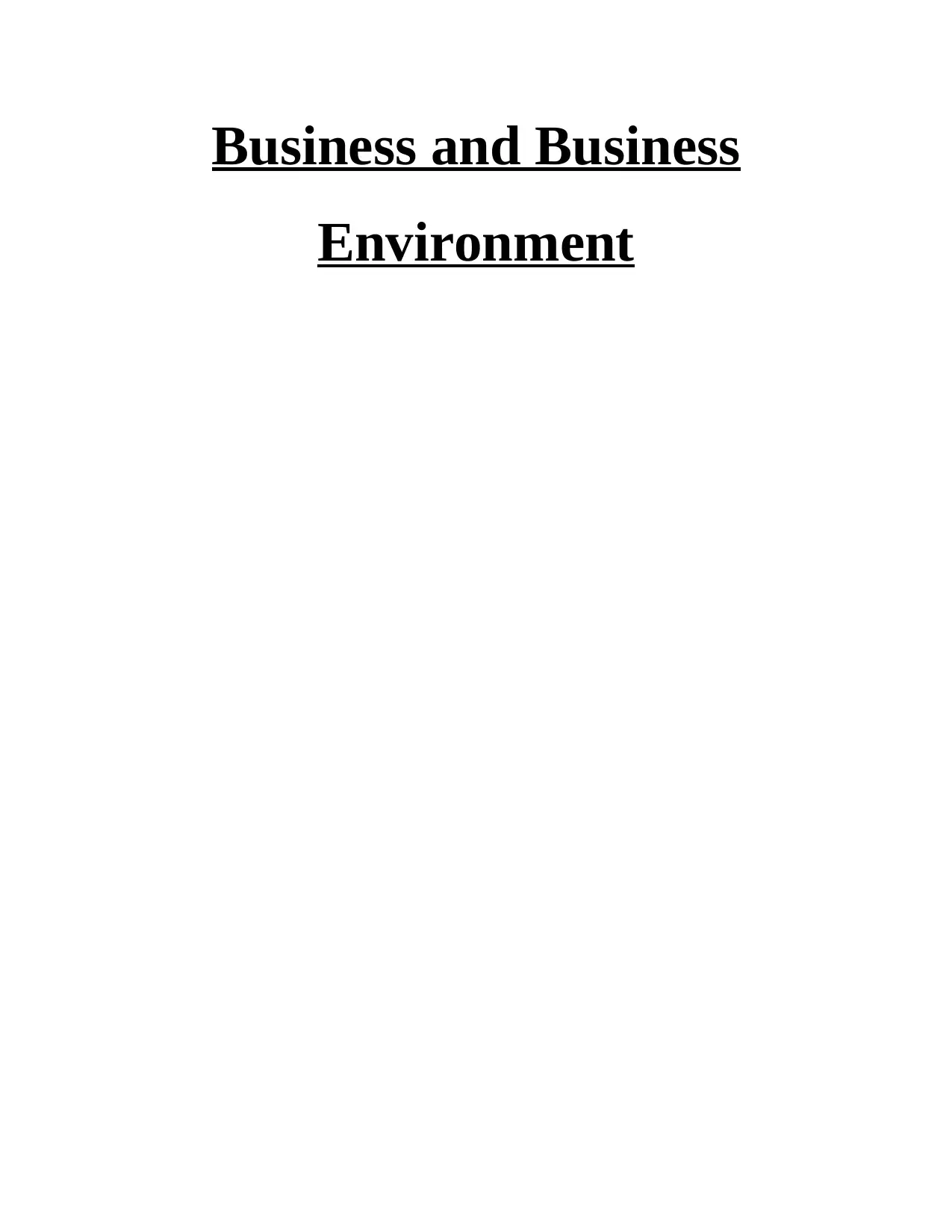
Business and Business
Environment
Environment
Paraphrase This Document
Need a fresh take? Get an instant paraphrase of this document with our AI Paraphraser
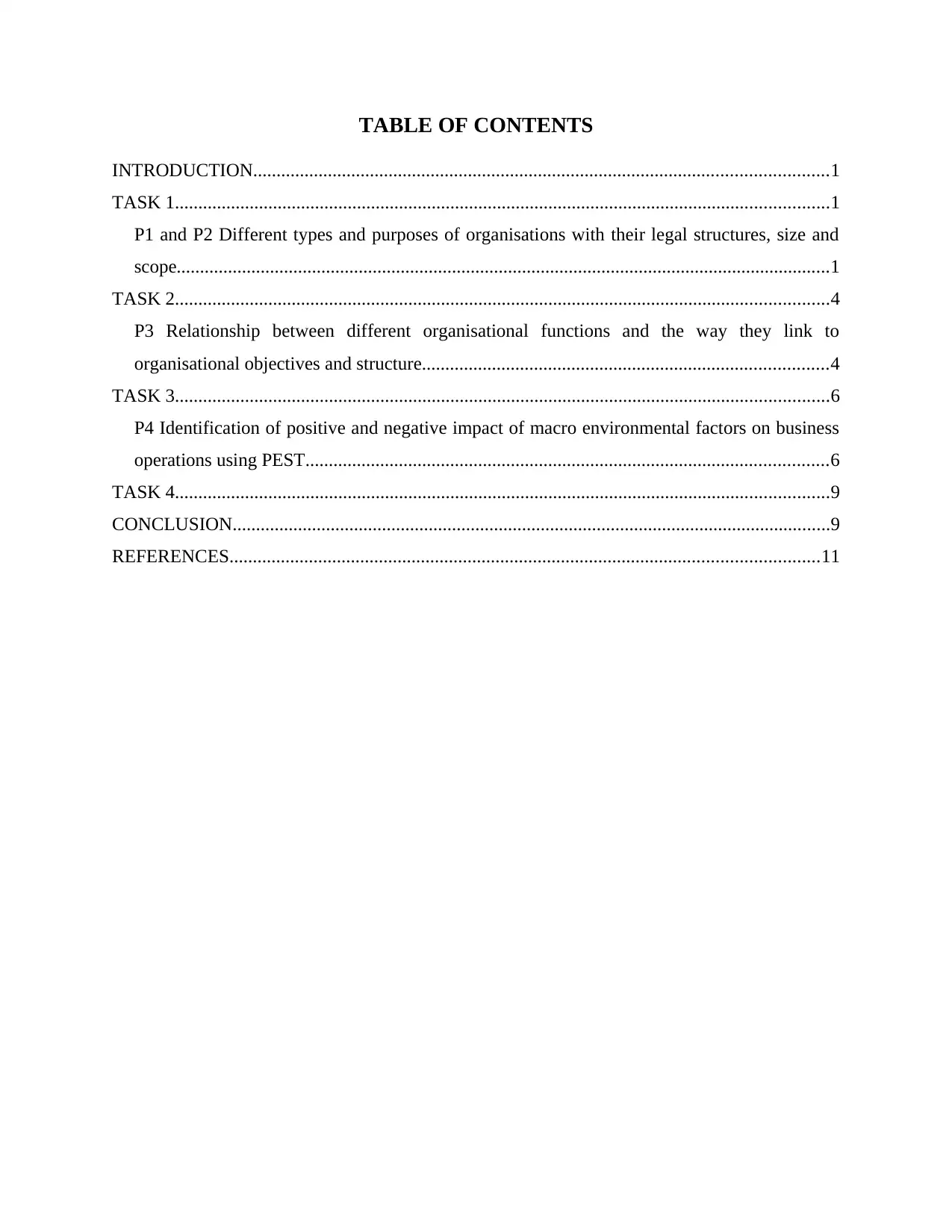
TABLE OF CONTENTS
INTRODUCTION...........................................................................................................................1
TASK 1............................................................................................................................................1
P1 and P2 Different types and purposes of organisations with their legal structures, size and
scope............................................................................................................................................1
TASK 2............................................................................................................................................4
P3 Relationship between different organisational functions and the way they link to
organisational objectives and structure.......................................................................................4
TASK 3............................................................................................................................................6
P4 Identification of positive and negative impact of macro environmental factors on business
operations using PEST................................................................................................................6
TASK 4............................................................................................................................................9
CONCLUSION................................................................................................................................9
REFERENCES..............................................................................................................................11
INTRODUCTION...........................................................................................................................1
TASK 1............................................................................................................................................1
P1 and P2 Different types and purposes of organisations with their legal structures, size and
scope............................................................................................................................................1
TASK 2............................................................................................................................................4
P3 Relationship between different organisational functions and the way they link to
organisational objectives and structure.......................................................................................4
TASK 3............................................................................................................................................6
P4 Identification of positive and negative impact of macro environmental factors on business
operations using PEST................................................................................................................6
TASK 4............................................................................................................................................9
CONCLUSION................................................................................................................................9
REFERENCES..............................................................................................................................11
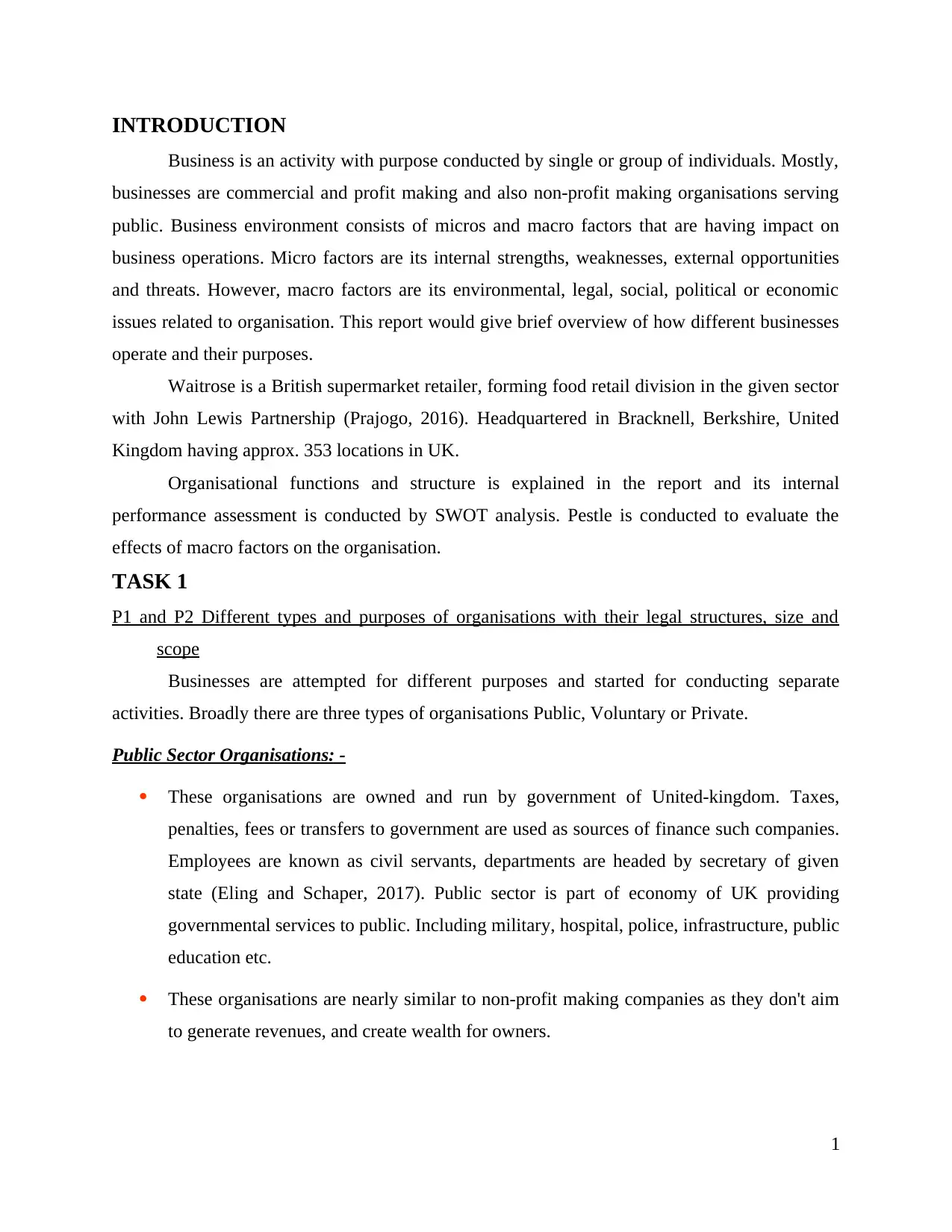
INTRODUCTION
Business is an activity with purpose conducted by single or group of individuals. Mostly,
businesses are commercial and profit making and also non-profit making organisations serving
public. Business environment consists of micros and macro factors that are having impact on
business operations. Micro factors are its internal strengths, weaknesses, external opportunities
and threats. However, macro factors are its environmental, legal, social, political or economic
issues related to organisation. This report would give brief overview of how different businesses
operate and their purposes.
Waitrose is a British supermarket retailer, forming food retail division in the given sector
with John Lewis Partnership (Prajogo, 2016). Headquartered in Bracknell, Berkshire, United
Kingdom having approx. 353 locations in UK.
Organisational functions and structure is explained in the report and its internal
performance assessment is conducted by SWOT analysis. Pestle is conducted to evaluate the
effects of macro factors on the organisation.
TASK 1
P1 and P2 Different types and purposes of organisations with their legal structures, size and
scope
Businesses are attempted for different purposes and started for conducting separate
activities. Broadly there are three types of organisations Public, Voluntary or Private.
Public Sector Organisations: -
These organisations are owned and run by government of United-kingdom. Taxes,
penalties, fees or transfers to government are used as sources of finance such companies.
Employees are known as civil servants, departments are headed by secretary of given
state (Eling and Schaper, 2017). Public sector is part of economy of UK providing
governmental services to public. Including military, hospital, police, infrastructure, public
education etc.
These organisations are nearly similar to non-profit making companies as they don't aim
to generate revenues, and create wealth for owners.
1
Business is an activity with purpose conducted by single or group of individuals. Mostly,
businesses are commercial and profit making and also non-profit making organisations serving
public. Business environment consists of micros and macro factors that are having impact on
business operations. Micro factors are its internal strengths, weaknesses, external opportunities
and threats. However, macro factors are its environmental, legal, social, political or economic
issues related to organisation. This report would give brief overview of how different businesses
operate and their purposes.
Waitrose is a British supermarket retailer, forming food retail division in the given sector
with John Lewis Partnership (Prajogo, 2016). Headquartered in Bracknell, Berkshire, United
Kingdom having approx. 353 locations in UK.
Organisational functions and structure is explained in the report and its internal
performance assessment is conducted by SWOT analysis. Pestle is conducted to evaluate the
effects of macro factors on the organisation.
TASK 1
P1 and P2 Different types and purposes of organisations with their legal structures, size and
scope
Businesses are attempted for different purposes and started for conducting separate
activities. Broadly there are three types of organisations Public, Voluntary or Private.
Public Sector Organisations: -
These organisations are owned and run by government of United-kingdom. Taxes,
penalties, fees or transfers to government are used as sources of finance such companies.
Employees are known as civil servants, departments are headed by secretary of given
state (Eling and Schaper, 2017). Public sector is part of economy of UK providing
governmental services to public. Including military, hospital, police, infrastructure, public
education etc.
These organisations are nearly similar to non-profit making companies as they don't aim
to generate revenues, and create wealth for owners.
1
⊘ This is a preview!⊘
Do you want full access?
Subscribe today to unlock all pages.

Trusted by 1+ million students worldwide
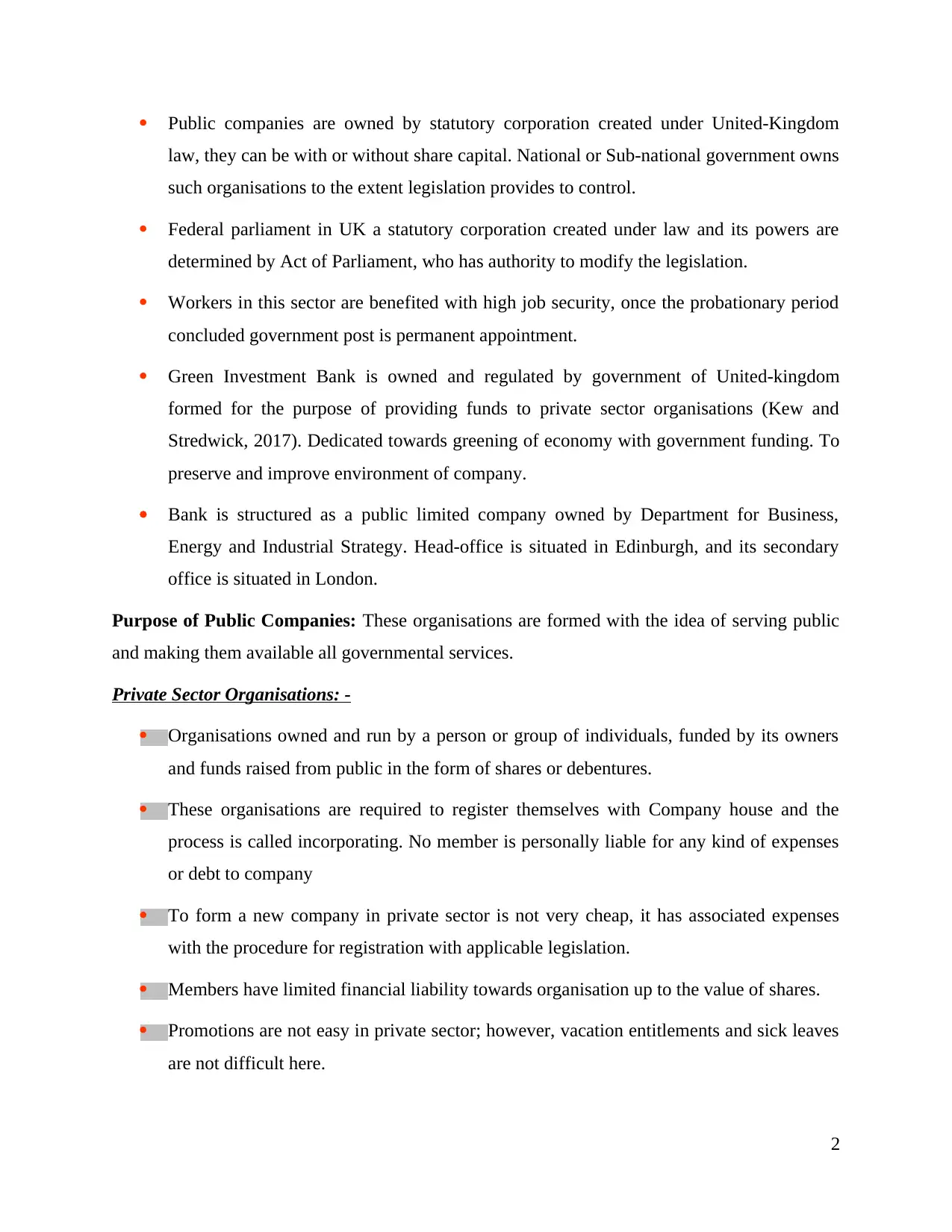
Public companies are owned by statutory corporation created under United-Kingdom
law, they can be with or without share capital. National or Sub-national government owns
such organisations to the extent legislation provides to control.
Federal parliament in UK a statutory corporation created under law and its powers are
determined by Act of Parliament, who has authority to modify the legislation.
Workers in this sector are benefited with high job security, once the probationary period
concluded government post is permanent appointment.
Green Investment Bank is owned and regulated by government of United-kingdom
formed for the purpose of providing funds to private sector organisations (Kew and
Stredwick, 2017). Dedicated towards greening of economy with government funding. To
preserve and improve environment of company.
Bank is structured as a public limited company owned by Department for Business,
Energy and Industrial Strategy. Head-office is situated in Edinburgh, and its secondary
office is situated in London.
Purpose of Public Companies: These organisations are formed with the idea of serving public
and making them available all governmental services.
Private Sector Organisations: -
Organisations owned and run by a person or group of individuals, funded by its owners
and funds raised from public in the form of shares or debentures.
These organisations are required to register themselves with Company house and the
process is called incorporating. No member is personally liable for any kind of expenses
or debt to company
To form a new company in private sector is not very cheap, it has associated expenses
with the procedure for registration with applicable legislation.
Members have limited financial liability towards organisation up to the value of shares.
Promotions are not easy in private sector; however, vacation entitlements and sick leaves
are not difficult here.
2
law, they can be with or without share capital. National or Sub-national government owns
such organisations to the extent legislation provides to control.
Federal parliament in UK a statutory corporation created under law and its powers are
determined by Act of Parliament, who has authority to modify the legislation.
Workers in this sector are benefited with high job security, once the probationary period
concluded government post is permanent appointment.
Green Investment Bank is owned and regulated by government of United-kingdom
formed for the purpose of providing funds to private sector organisations (Kew and
Stredwick, 2017). Dedicated towards greening of economy with government funding. To
preserve and improve environment of company.
Bank is structured as a public limited company owned by Department for Business,
Energy and Industrial Strategy. Head-office is situated in Edinburgh, and its secondary
office is situated in London.
Purpose of Public Companies: These organisations are formed with the idea of serving public
and making them available all governmental services.
Private Sector Organisations: -
Organisations owned and run by a person or group of individuals, funded by its owners
and funds raised from public in the form of shares or debentures.
These organisations are required to register themselves with Company house and the
process is called incorporating. No member is personally liable for any kind of expenses
or debt to company
To form a new company in private sector is not very cheap, it has associated expenses
with the procedure for registration with applicable legislation.
Members have limited financial liability towards organisation up to the value of shares.
Promotions are not easy in private sector; however, vacation entitlements and sick leaves
are not difficult here.
2
Paraphrase This Document
Need a fresh take? Get an instant paraphrase of this document with our AI Paraphraser
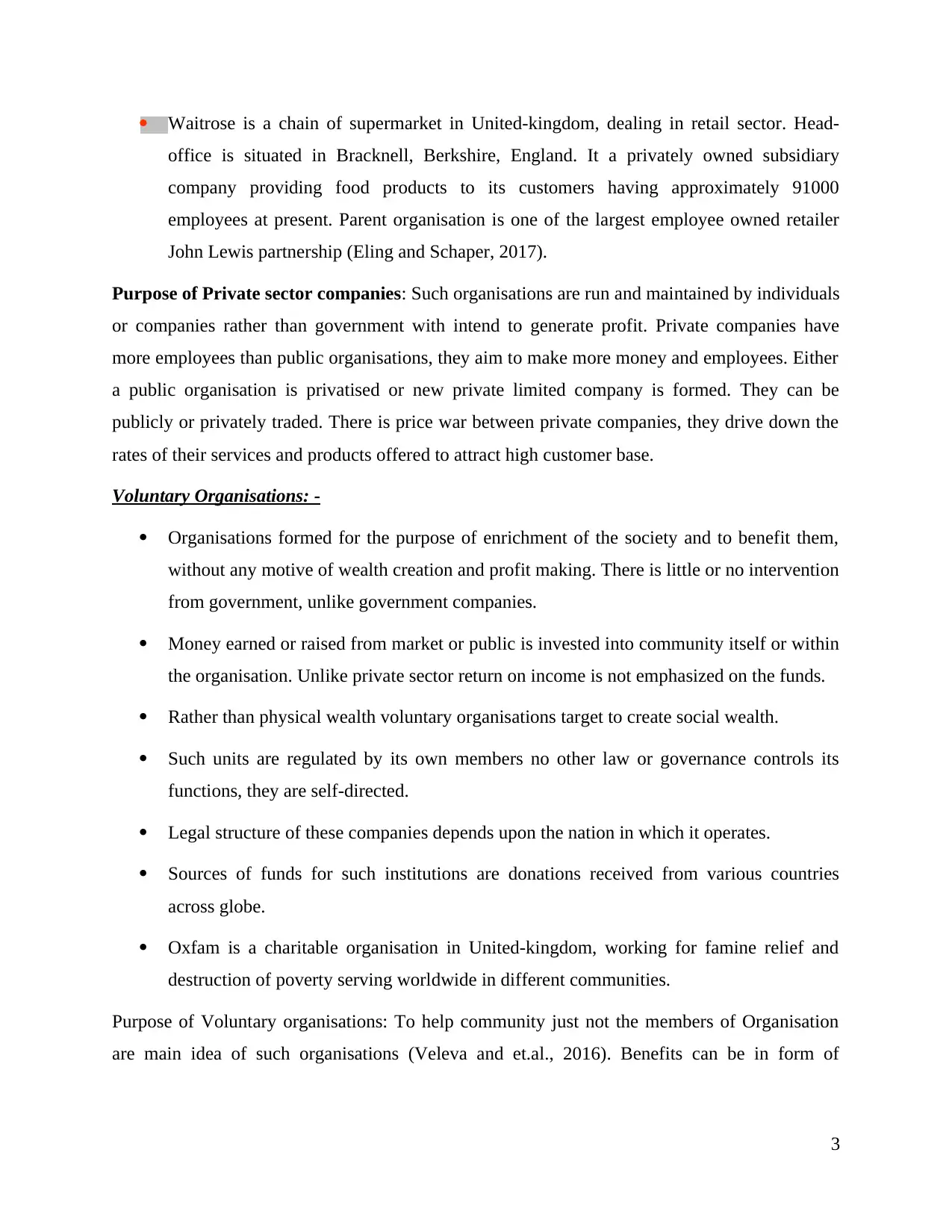
Waitrose is a chain of supermarket in United-kingdom, dealing in retail sector. Head-
office is situated in Bracknell, Berkshire, England. It a privately owned subsidiary
company providing food products to its customers having approximately 91000
employees at present. Parent organisation is one of the largest employee owned retailer
John Lewis partnership (Eling and Schaper, 2017).
Purpose of Private sector companies: Such organisations are run and maintained by individuals
or companies rather than government with intend to generate profit. Private companies have
more employees than public organisations, they aim to make more money and employees. Either
a public organisation is privatised or new private limited company is formed. They can be
publicly or privately traded. There is price war between private companies, they drive down the
rates of their services and products offered to attract high customer base.
Voluntary Organisations: -
Organisations formed for the purpose of enrichment of the society and to benefit them,
without any motive of wealth creation and profit making. There is little or no intervention
from government, unlike government companies.
Money earned or raised from market or public is invested into community itself or within
the organisation. Unlike private sector return on income is not emphasized on the funds.
Rather than physical wealth voluntary organisations target to create social wealth.
Such units are regulated by its own members no other law or governance controls its
functions, they are self-directed.
Legal structure of these companies depends upon the nation in which it operates.
Sources of funds for such institutions are donations received from various countries
across globe.
Oxfam is a charitable organisation in United-kingdom, working for famine relief and
destruction of poverty serving worldwide in different communities.
Purpose of Voluntary organisations: To help community just not the members of Organisation
are main idea of such organisations (Veleva and et.al., 2016). Benefits can be in form of
3
office is situated in Bracknell, Berkshire, England. It a privately owned subsidiary
company providing food products to its customers having approximately 91000
employees at present. Parent organisation is one of the largest employee owned retailer
John Lewis partnership (Eling and Schaper, 2017).
Purpose of Private sector companies: Such organisations are run and maintained by individuals
or companies rather than government with intend to generate profit. Private companies have
more employees than public organisations, they aim to make more money and employees. Either
a public organisation is privatised or new private limited company is formed. They can be
publicly or privately traded. There is price war between private companies, they drive down the
rates of their services and products offered to attract high customer base.
Voluntary Organisations: -
Organisations formed for the purpose of enrichment of the society and to benefit them,
without any motive of wealth creation and profit making. There is little or no intervention
from government, unlike government companies.
Money earned or raised from market or public is invested into community itself or within
the organisation. Unlike private sector return on income is not emphasized on the funds.
Rather than physical wealth voluntary organisations target to create social wealth.
Such units are regulated by its own members no other law or governance controls its
functions, they are self-directed.
Legal structure of these companies depends upon the nation in which it operates.
Sources of funds for such institutions are donations received from various countries
across globe.
Oxfam is a charitable organisation in United-kingdom, working for famine relief and
destruction of poverty serving worldwide in different communities.
Purpose of Voluntary organisations: To help community just not the members of Organisation
are main idea of such organisations (Veleva and et.al., 2016). Benefits can be in form of
3
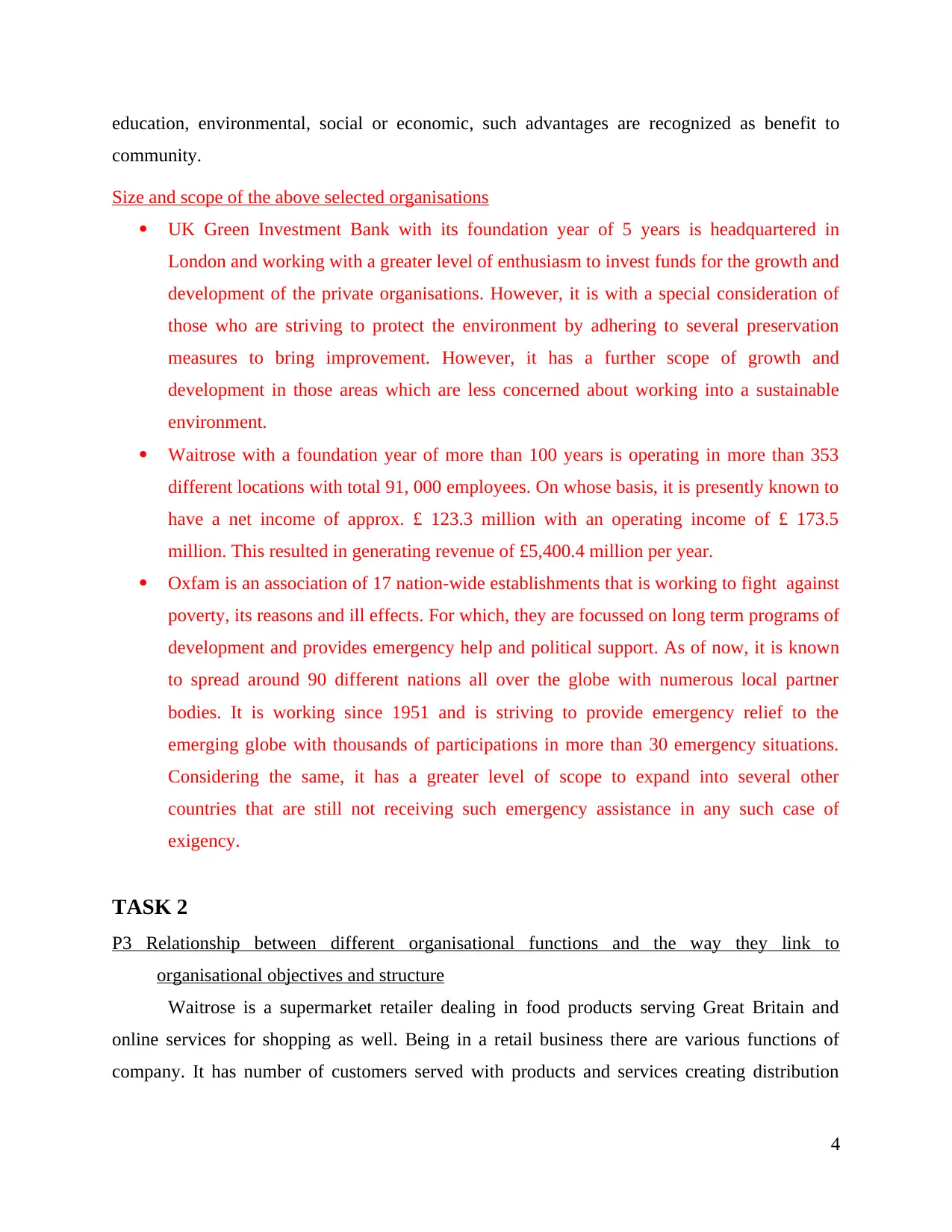
education, environmental, social or economic, such advantages are recognized as benefit to
community.
Size and scope of the above selected organisations
UK Green Investment Bank with its foundation year of 5 years is headquartered in
London and working with a greater level of enthusiasm to invest funds for the growth and
development of the private organisations. However, it is with a special consideration of
those who are striving to protect the environment by adhering to several preservation
measures to bring improvement. However, it has a further scope of growth and
development in those areas which are less concerned about working into a sustainable
environment.
Waitrose with a foundation year of more than 100 years is operating in more than 353
different locations with total 91, 000 employees. On whose basis, it is presently known to
have a net income of approx. £ 123.3 million with an operating income of £ 173.5
million. This resulted in generating revenue of £5,400.4 million per year.
Oxfam is an association of 17 nation-wide establishments that is working to fight against
poverty, its reasons and ill effects. For which, they are focussed on long term programs of
development and provides emergency help and political support. As of now, it is known
to spread around 90 different nations all over the globe with numerous local partner
bodies. It is working since 1951 and is striving to provide emergency relief to the
emerging globe with thousands of participations in more than 30 emergency situations.
Considering the same, it has a greater level of scope to expand into several other
countries that are still not receiving such emergency assistance in any such case of
exigency.
TASK 2
P3 Relationship between different organisational functions and the way they link to
organisational objectives and structure
Waitrose is a supermarket retailer dealing in food products serving Great Britain and
online services for shopping as well. Being in a retail business there are various functions of
company. It has number of customers served with products and services creating distribution
4
community.
Size and scope of the above selected organisations
UK Green Investment Bank with its foundation year of 5 years is headquartered in
London and working with a greater level of enthusiasm to invest funds for the growth and
development of the private organisations. However, it is with a special consideration of
those who are striving to protect the environment by adhering to several preservation
measures to bring improvement. However, it has a further scope of growth and
development in those areas which are less concerned about working into a sustainable
environment.
Waitrose with a foundation year of more than 100 years is operating in more than 353
different locations with total 91, 000 employees. On whose basis, it is presently known to
have a net income of approx. £ 123.3 million with an operating income of £ 173.5
million. This resulted in generating revenue of £5,400.4 million per year.
Oxfam is an association of 17 nation-wide establishments that is working to fight against
poverty, its reasons and ill effects. For which, they are focussed on long term programs of
development and provides emergency help and political support. As of now, it is known
to spread around 90 different nations all over the globe with numerous local partner
bodies. It is working since 1951 and is striving to provide emergency relief to the
emerging globe with thousands of participations in more than 30 emergency situations.
Considering the same, it has a greater level of scope to expand into several other
countries that are still not receiving such emergency assistance in any such case of
exigency.
TASK 2
P3 Relationship between different organisational functions and the way they link to
organisational objectives and structure
Waitrose is a supermarket retailer dealing in food products serving Great Britain and
online services for shopping as well. Being in a retail business there are various functions of
company. It has number of customers served with products and services creating distribution
4
⊘ This is a preview!⊘
Do you want full access?
Subscribe today to unlock all pages.

Trusted by 1+ million students worldwide
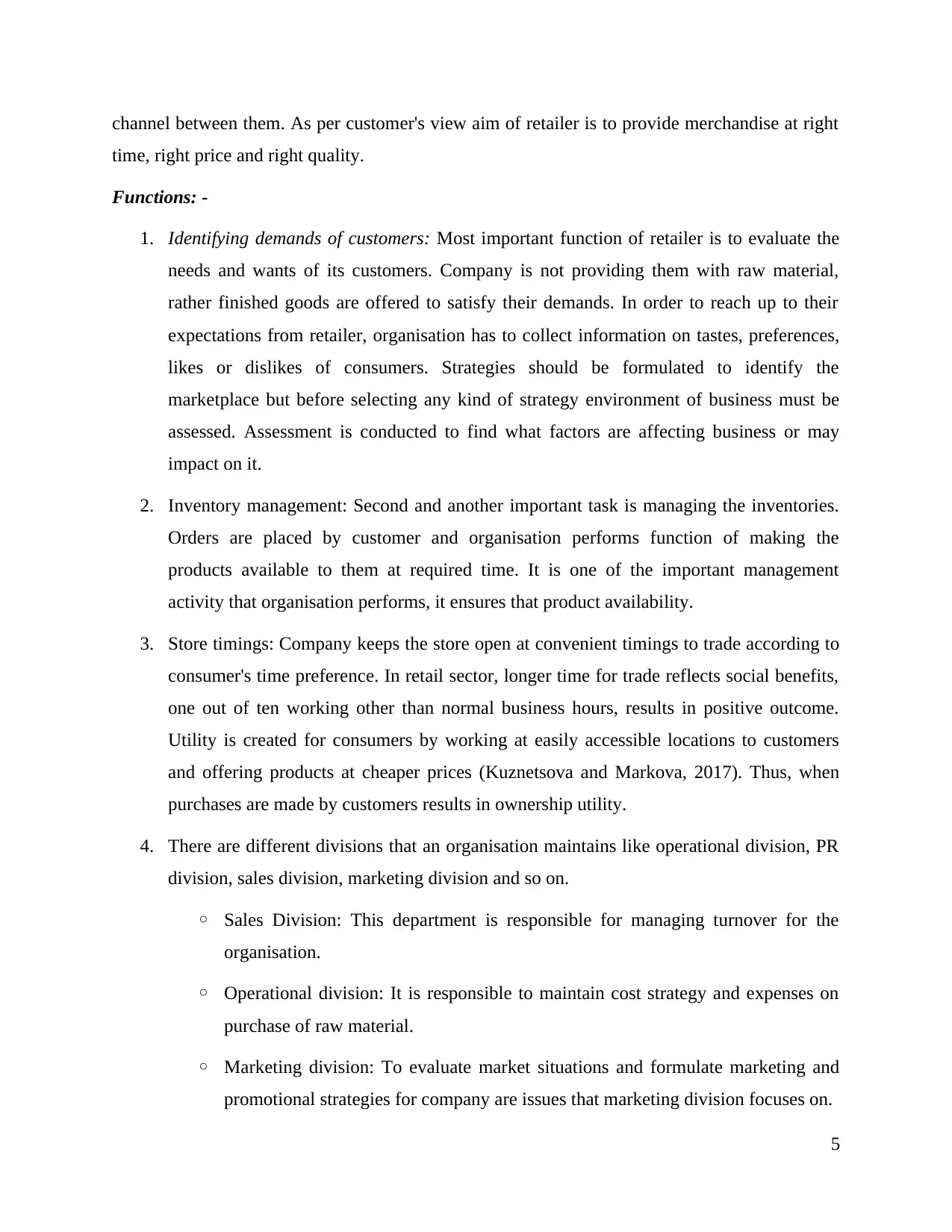
channel between them. As per customer's view aim of retailer is to provide merchandise at right
time, right price and right quality.
Functions: -
1. Identifying demands of customers: Most important function of retailer is to evaluate the
needs and wants of its customers. Company is not providing them with raw material,
rather finished goods are offered to satisfy their demands. In order to reach up to their
expectations from retailer, organisation has to collect information on tastes, preferences,
likes or dislikes of consumers. Strategies should be formulated to identify the
marketplace but before selecting any kind of strategy environment of business must be
assessed. Assessment is conducted to find what factors are affecting business or may
impact on it.
2. Inventory management: Second and another important task is managing the inventories.
Orders are placed by customer and organisation performs function of making the
products available to them at required time. It is one of the important management
activity that organisation performs, it ensures that product availability.
3. Store timings: Company keeps the store open at convenient timings to trade according to
consumer's time preference. In retail sector, longer time for trade reflects social benefits,
one out of ten working other than normal business hours, results in positive outcome.
Utility is created for consumers by working at easily accessible locations to customers
and offering products at cheaper prices (Kuznetsova and Markova, 2017). Thus, when
purchases are made by customers results in ownership utility.
4. There are different divisions that an organisation maintains like operational division, PR
division, sales division, marketing division and so on.
◦ Sales Division: This department is responsible for managing turnover for the
organisation.
◦ Operational division: It is responsible to maintain cost strategy and expenses on
purchase of raw material.
◦ Marketing division: To evaluate market situations and formulate marketing and
promotional strategies for company are issues that marketing division focuses on.
5
time, right price and right quality.
Functions: -
1. Identifying demands of customers: Most important function of retailer is to evaluate the
needs and wants of its customers. Company is not providing them with raw material,
rather finished goods are offered to satisfy their demands. In order to reach up to their
expectations from retailer, organisation has to collect information on tastes, preferences,
likes or dislikes of consumers. Strategies should be formulated to identify the
marketplace but before selecting any kind of strategy environment of business must be
assessed. Assessment is conducted to find what factors are affecting business or may
impact on it.
2. Inventory management: Second and another important task is managing the inventories.
Orders are placed by customer and organisation performs function of making the
products available to them at required time. It is one of the important management
activity that organisation performs, it ensures that product availability.
3. Store timings: Company keeps the store open at convenient timings to trade according to
consumer's time preference. In retail sector, longer time for trade reflects social benefits,
one out of ten working other than normal business hours, results in positive outcome.
Utility is created for consumers by working at easily accessible locations to customers
and offering products at cheaper prices (Kuznetsova and Markova, 2017). Thus, when
purchases are made by customers results in ownership utility.
4. There are different divisions that an organisation maintains like operational division, PR
division, sales division, marketing division and so on.
◦ Sales Division: This department is responsible for managing turnover for the
organisation.
◦ Operational division: It is responsible to maintain cost strategy and expenses on
purchase of raw material.
◦ Marketing division: To evaluate market situations and formulate marketing and
promotional strategies for company are issues that marketing division focuses on.
5
Paraphrase This Document
Need a fresh take? Get an instant paraphrase of this document with our AI Paraphraser
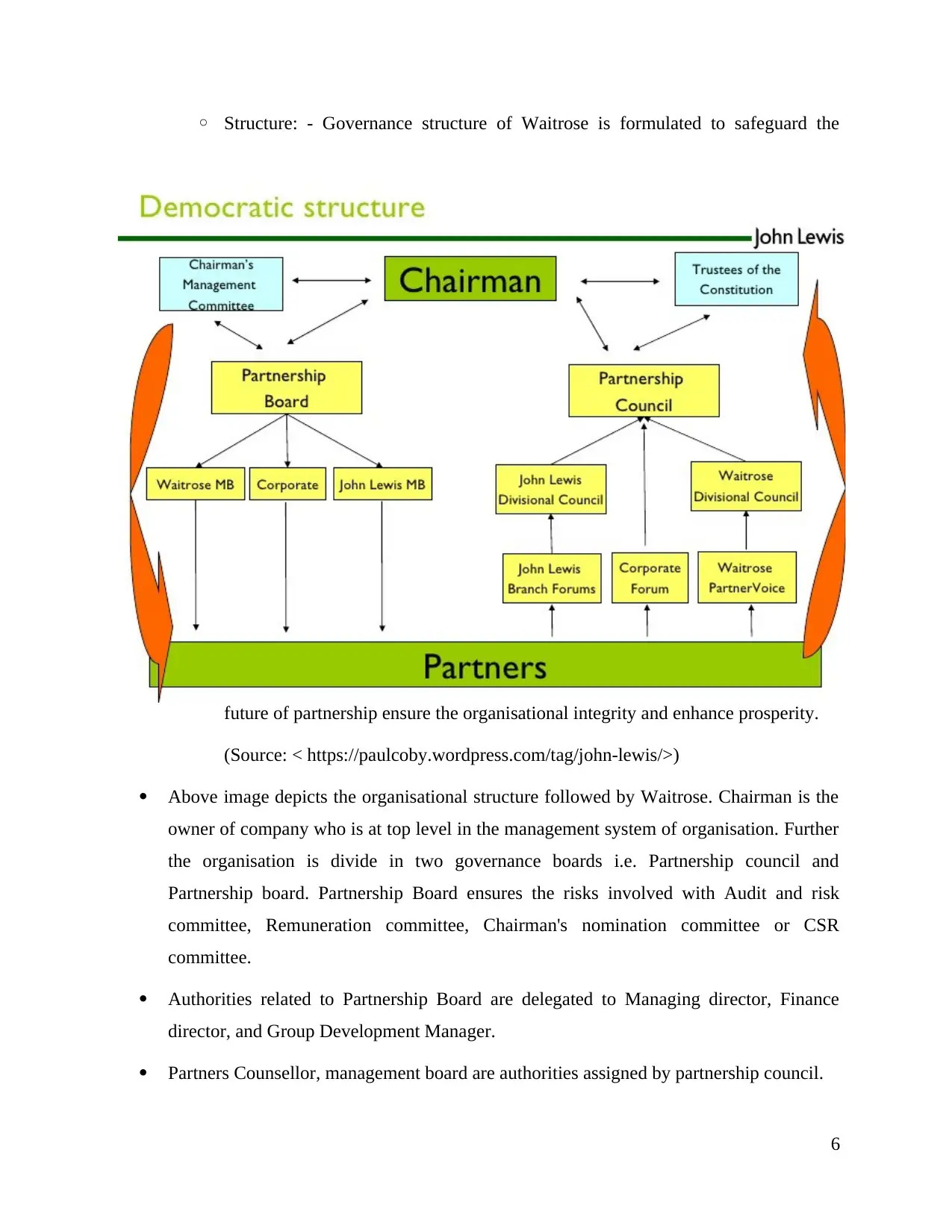
◦ Structure: - Governance structure of Waitrose is formulated to safeguard the
future of partnership ensure the organisational integrity and enhance prosperity.
(Source: < https://paulcoby.wordpress.com/tag/john-lewis/>)
Above image depicts the organisational structure followed by Waitrose. Chairman is the
owner of company who is at top level in the management system of organisation. Further
the organisation is divide in two governance boards i.e. Partnership council and
Partnership board. Partnership Board ensures the risks involved with Audit and risk
committee, Remuneration committee, Chairman's nomination committee or CSR
committee.
Authorities related to Partnership Board are delegated to Managing director, Finance
director, and Group Development Manager.
Partners Counsellor, management board are authorities assigned by partnership council.
6
future of partnership ensure the organisational integrity and enhance prosperity.
(Source: < https://paulcoby.wordpress.com/tag/john-lewis/>)
Above image depicts the organisational structure followed by Waitrose. Chairman is the
owner of company who is at top level in the management system of organisation. Further
the organisation is divide in two governance boards i.e. Partnership council and
Partnership board. Partnership Board ensures the risks involved with Audit and risk
committee, Remuneration committee, Chairman's nomination committee or CSR
committee.
Authorities related to Partnership Board are delegated to Managing director, Finance
director, and Group Development Manager.
Partners Counsellor, management board are authorities assigned by partnership council.
6
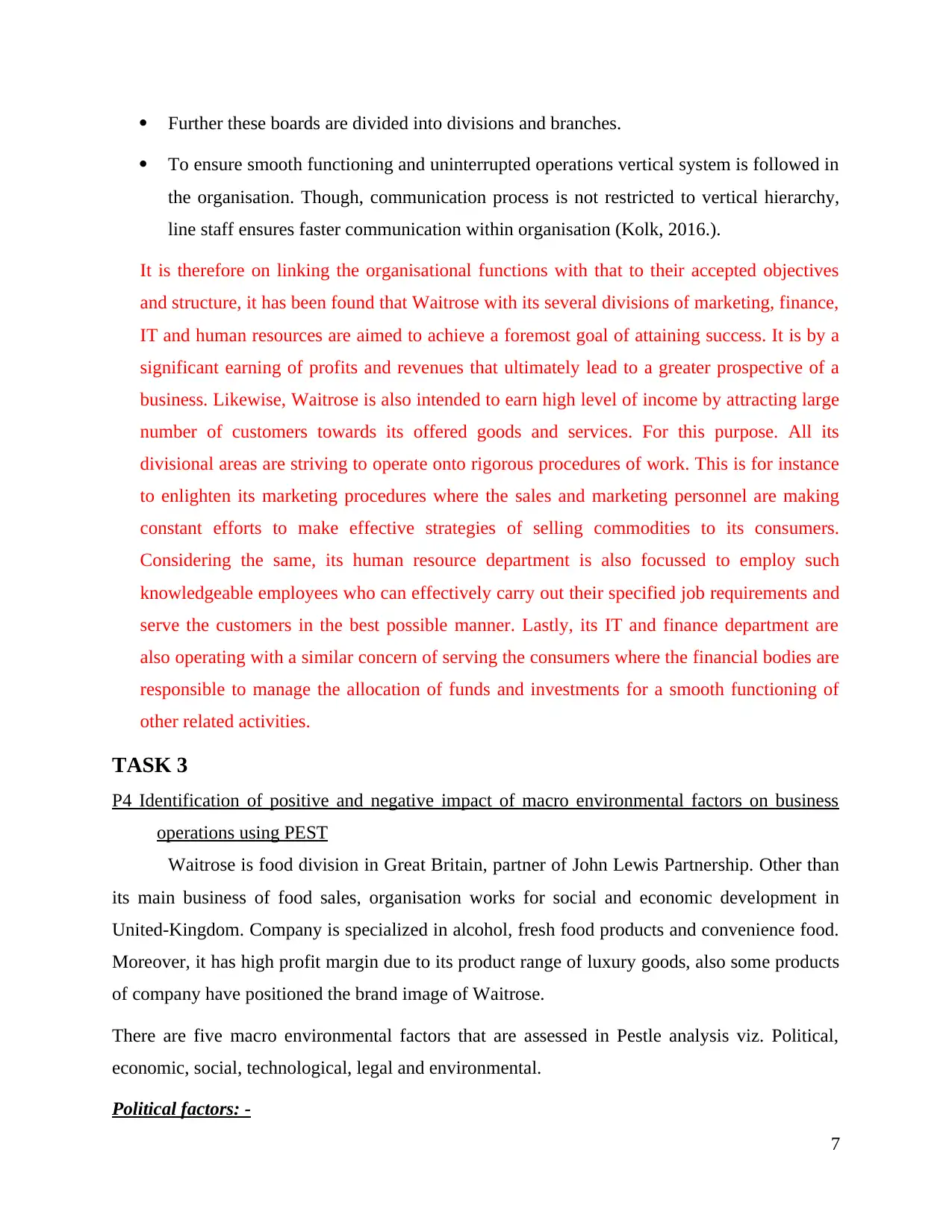
Further these boards are divided into divisions and branches.
To ensure smooth functioning and uninterrupted operations vertical system is followed in
the organisation. Though, communication process is not restricted to vertical hierarchy,
line staff ensures faster communication within organisation (Kolk, 2016.).
It is therefore on linking the organisational functions with that to their accepted objectives
and structure, it has been found that Waitrose with its several divisions of marketing, finance,
IT and human resources are aimed to achieve a foremost goal of attaining success. It is by a
significant earning of profits and revenues that ultimately lead to a greater prospective of a
business. Likewise, Waitrose is also intended to earn high level of income by attracting large
number of customers towards its offered goods and services. For this purpose. All its
divisional areas are striving to operate onto rigorous procedures of work. This is for instance
to enlighten its marketing procedures where the sales and marketing personnel are making
constant efforts to make effective strategies of selling commodities to its consumers.
Considering the same, its human resource department is also focussed to employ such
knowledgeable employees who can effectively carry out their specified job requirements and
serve the customers in the best possible manner. Lastly, its IT and finance department are
also operating with a similar concern of serving the consumers where the financial bodies are
responsible to manage the allocation of funds and investments for a smooth functioning of
other related activities.
TASK 3
P4 Identification of positive and negative impact of macro environmental factors on business
operations using PEST
Waitrose is food division in Great Britain, partner of John Lewis Partnership. Other than
its main business of food sales, organisation works for social and economic development in
United-Kingdom. Company is specialized in alcohol, fresh food products and convenience food.
Moreover, it has high profit margin due to its product range of luxury goods, also some products
of company have positioned the brand image of Waitrose.
There are five macro environmental factors that are assessed in Pestle analysis viz. Political,
economic, social, technological, legal and environmental.
Political factors: -
7
To ensure smooth functioning and uninterrupted operations vertical system is followed in
the organisation. Though, communication process is not restricted to vertical hierarchy,
line staff ensures faster communication within organisation (Kolk, 2016.).
It is therefore on linking the organisational functions with that to their accepted objectives
and structure, it has been found that Waitrose with its several divisions of marketing, finance,
IT and human resources are aimed to achieve a foremost goal of attaining success. It is by a
significant earning of profits and revenues that ultimately lead to a greater prospective of a
business. Likewise, Waitrose is also intended to earn high level of income by attracting large
number of customers towards its offered goods and services. For this purpose. All its
divisional areas are striving to operate onto rigorous procedures of work. This is for instance
to enlighten its marketing procedures where the sales and marketing personnel are making
constant efforts to make effective strategies of selling commodities to its consumers.
Considering the same, its human resource department is also focussed to employ such
knowledgeable employees who can effectively carry out their specified job requirements and
serve the customers in the best possible manner. Lastly, its IT and finance department are
also operating with a similar concern of serving the consumers where the financial bodies are
responsible to manage the allocation of funds and investments for a smooth functioning of
other related activities.
TASK 3
P4 Identification of positive and negative impact of macro environmental factors on business
operations using PEST
Waitrose is food division in Great Britain, partner of John Lewis Partnership. Other than
its main business of food sales, organisation works for social and economic development in
United-Kingdom. Company is specialized in alcohol, fresh food products and convenience food.
Moreover, it has high profit margin due to its product range of luxury goods, also some products
of company have positioned the brand image of Waitrose.
There are five macro environmental factors that are assessed in Pestle analysis viz. Political,
economic, social, technological, legal and environmental.
Political factors: -
7
⊘ This is a preview!⊘
Do you want full access?
Subscribe today to unlock all pages.

Trusted by 1+ million students worldwide
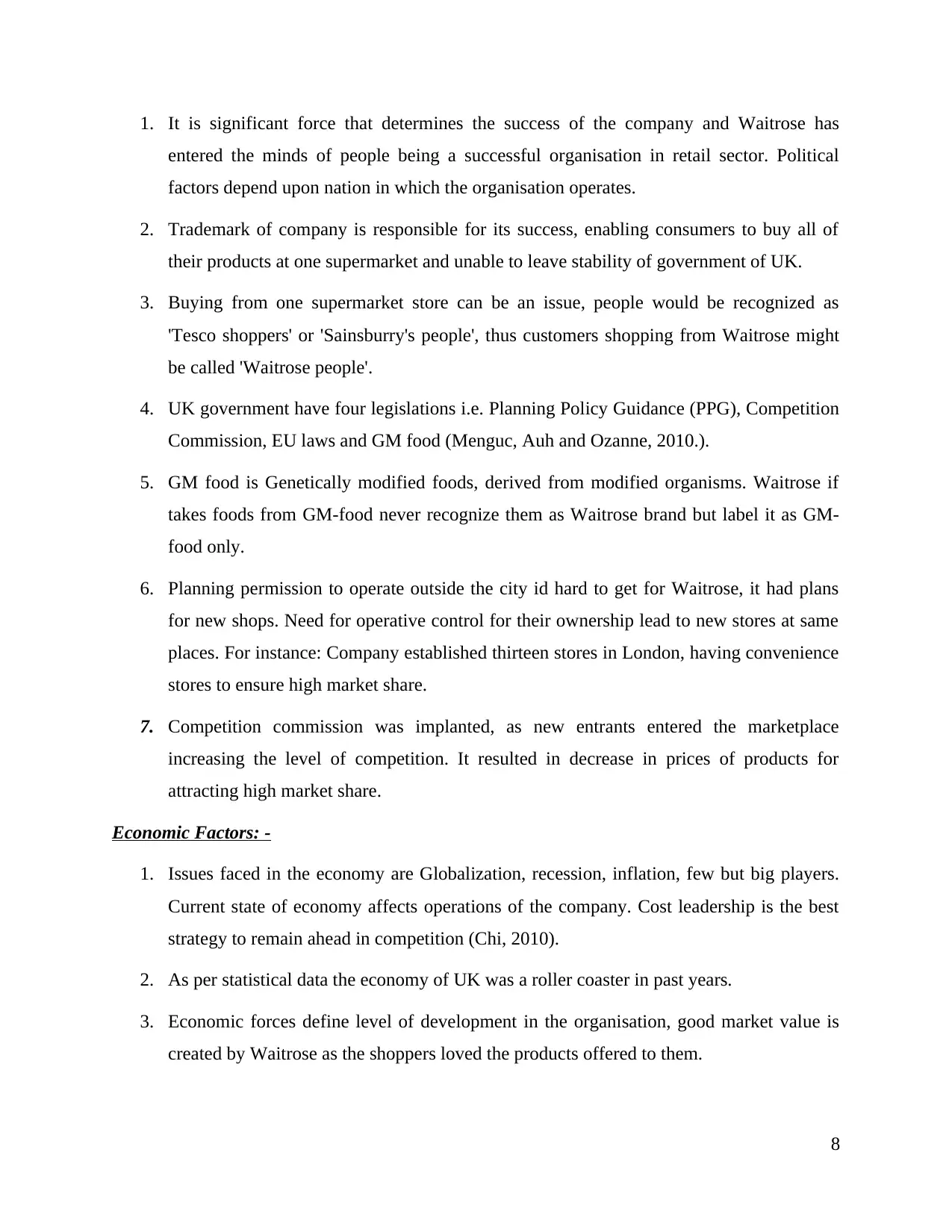
1. It is significant force that determines the success of the company and Waitrose has
entered the minds of people being a successful organisation in retail sector. Political
factors depend upon nation in which the organisation operates.
2. Trademark of company is responsible for its success, enabling consumers to buy all of
their products at one supermarket and unable to leave stability of government of UK.
3. Buying from one supermarket store can be an issue, people would be recognized as
'Tesco shoppers' or 'Sainsburry's people', thus customers shopping from Waitrose might
be called 'Waitrose people'.
4. UK government have four legislations i.e. Planning Policy Guidance (PPG), Competition
Commission, EU laws and GM food (Menguc, Auh and Ozanne, 2010.).
5. GM food is Genetically modified foods, derived from modified organisms. Waitrose if
takes foods from GM-food never recognize them as Waitrose brand but label it as GM-
food only.
6. Planning permission to operate outside the city id hard to get for Waitrose, it had plans
for new shops. Need for operative control for their ownership lead to new stores at same
places. For instance: Company established thirteen stores in London, having convenience
stores to ensure high market share.
7. Competition commission was implanted, as new entrants entered the marketplace
increasing the level of competition. It resulted in decrease in prices of products for
attracting high market share.
Economic Factors: -
1. Issues faced in the economy are Globalization, recession, inflation, few but big players.
Current state of economy affects operations of the company. Cost leadership is the best
strategy to remain ahead in competition (Chi, 2010).
2. As per statistical data the economy of UK was a roller coaster in past years.
3. Economic forces define level of development in the organisation, good market value is
created by Waitrose as the shoppers loved the products offered to them.
8
entered the minds of people being a successful organisation in retail sector. Political
factors depend upon nation in which the organisation operates.
2. Trademark of company is responsible for its success, enabling consumers to buy all of
their products at one supermarket and unable to leave stability of government of UK.
3. Buying from one supermarket store can be an issue, people would be recognized as
'Tesco shoppers' or 'Sainsburry's people', thus customers shopping from Waitrose might
be called 'Waitrose people'.
4. UK government have four legislations i.e. Planning Policy Guidance (PPG), Competition
Commission, EU laws and GM food (Menguc, Auh and Ozanne, 2010.).
5. GM food is Genetically modified foods, derived from modified organisms. Waitrose if
takes foods from GM-food never recognize them as Waitrose brand but label it as GM-
food only.
6. Planning permission to operate outside the city id hard to get for Waitrose, it had plans
for new shops. Need for operative control for their ownership lead to new stores at same
places. For instance: Company established thirteen stores in London, having convenience
stores to ensure high market share.
7. Competition commission was implanted, as new entrants entered the marketplace
increasing the level of competition. It resulted in decrease in prices of products for
attracting high market share.
Economic Factors: -
1. Issues faced in the economy are Globalization, recession, inflation, few but big players.
Current state of economy affects operations of the company. Cost leadership is the best
strategy to remain ahead in competition (Chi, 2010).
2. As per statistical data the economy of UK was a roller coaster in past years.
3. Economic forces define level of development in the organisation, good market value is
created by Waitrose as the shoppers loved the products offered to them.
8
Paraphrase This Document
Need a fresh take? Get an instant paraphrase of this document with our AI Paraphraser
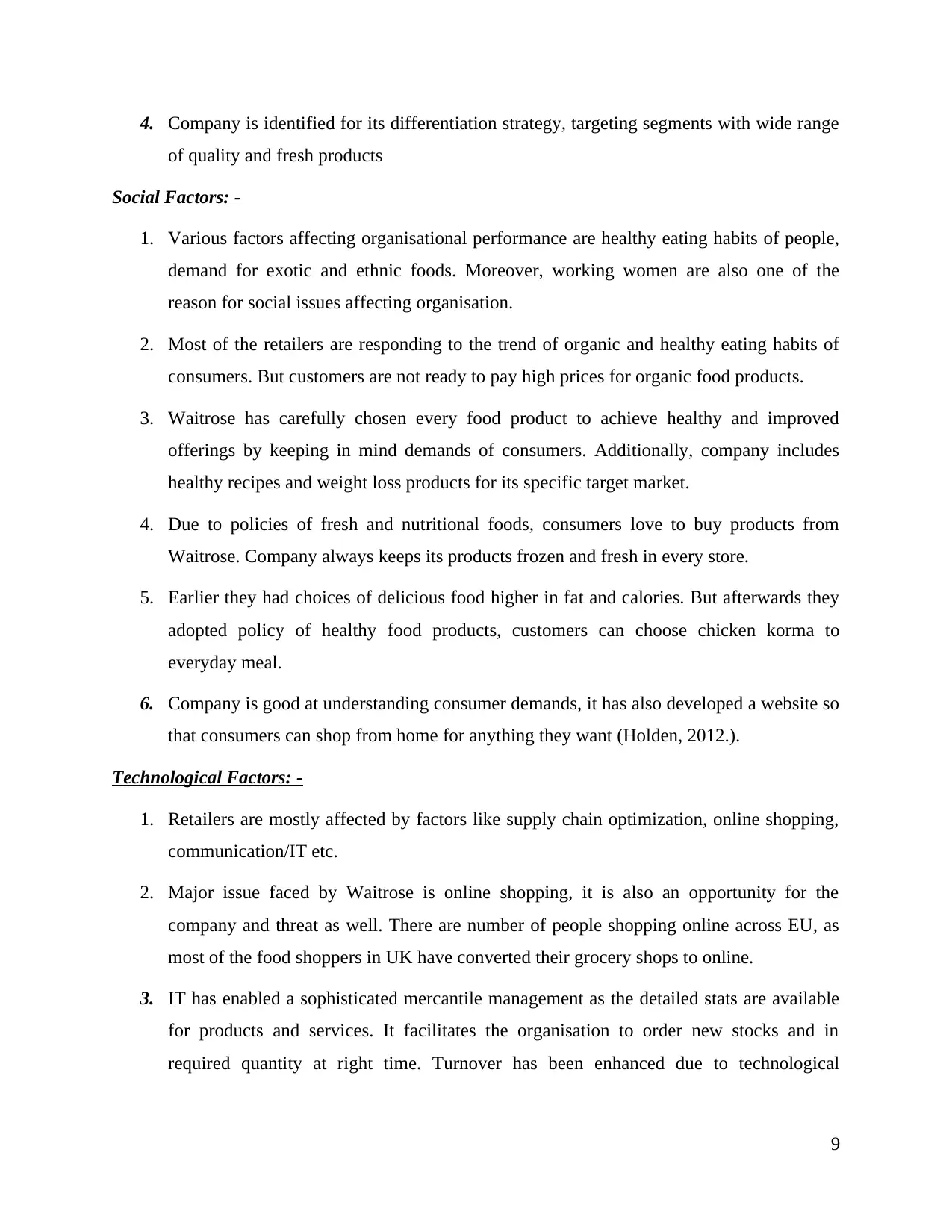
4. Company is identified for its differentiation strategy, targeting segments with wide range
of quality and fresh products
Social Factors: -
1. Various factors affecting organisational performance are healthy eating habits of people,
demand for exotic and ethnic foods. Moreover, working women are also one of the
reason for social issues affecting organisation.
2. Most of the retailers are responding to the trend of organic and healthy eating habits of
consumers. But customers are not ready to pay high prices for organic food products.
3. Waitrose has carefully chosen every food product to achieve healthy and improved
offerings by keeping in mind demands of consumers. Additionally, company includes
healthy recipes and weight loss products for its specific target market.
4. Due to policies of fresh and nutritional foods, consumers love to buy products from
Waitrose. Company always keeps its products frozen and fresh in every store.
5. Earlier they had choices of delicious food higher in fat and calories. But afterwards they
adopted policy of healthy food products, customers can choose chicken korma to
everyday meal.
6. Company is good at understanding consumer demands, it has also developed a website so
that consumers can shop from home for anything they want (Holden, 2012.).
Technological Factors: -
1. Retailers are mostly affected by factors like supply chain optimization, online shopping,
communication/IT etc.
2. Major issue faced by Waitrose is online shopping, it is also an opportunity for the
company and threat as well. There are number of people shopping online across EU, as
most of the food shoppers in UK have converted their grocery shops to online.
3. IT has enabled a sophisticated mercantile management as the detailed stats are available
for products and services. It facilitates the organisation to order new stocks and in
required quantity at right time. Turnover has been enhanced due to technological
9
of quality and fresh products
Social Factors: -
1. Various factors affecting organisational performance are healthy eating habits of people,
demand for exotic and ethnic foods. Moreover, working women are also one of the
reason for social issues affecting organisation.
2. Most of the retailers are responding to the trend of organic and healthy eating habits of
consumers. But customers are not ready to pay high prices for organic food products.
3. Waitrose has carefully chosen every food product to achieve healthy and improved
offerings by keeping in mind demands of consumers. Additionally, company includes
healthy recipes and weight loss products for its specific target market.
4. Due to policies of fresh and nutritional foods, consumers love to buy products from
Waitrose. Company always keeps its products frozen and fresh in every store.
5. Earlier they had choices of delicious food higher in fat and calories. But afterwards they
adopted policy of healthy food products, customers can choose chicken korma to
everyday meal.
6. Company is good at understanding consumer demands, it has also developed a website so
that consumers can shop from home for anything they want (Holden, 2012.).
Technological Factors: -
1. Retailers are mostly affected by factors like supply chain optimization, online shopping,
communication/IT etc.
2. Major issue faced by Waitrose is online shopping, it is also an opportunity for the
company and threat as well. There are number of people shopping online across EU, as
most of the food shoppers in UK have converted their grocery shops to online.
3. IT has enabled a sophisticated mercantile management as the detailed stats are available
for products and services. It facilitates the organisation to order new stocks and in
required quantity at right time. Turnover has been enhanced due to technological
9
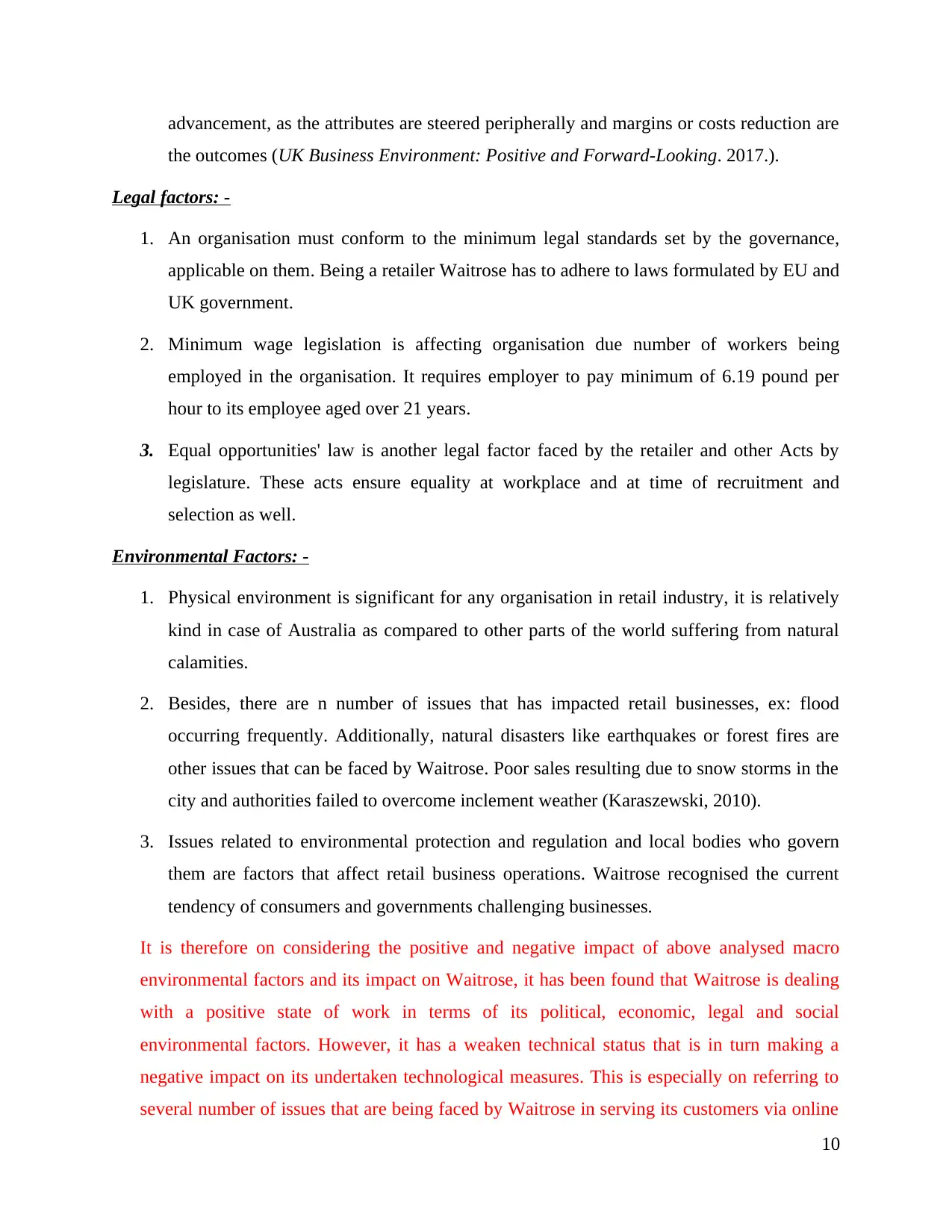
advancement, as the attributes are steered peripherally and margins or costs reduction are
the outcomes (UK Business Environment: Positive and Forward-Looking. 2017.).
Legal factors: -
1. An organisation must conform to the minimum legal standards set by the governance,
applicable on them. Being a retailer Waitrose has to adhere to laws formulated by EU and
UK government.
2. Minimum wage legislation is affecting organisation due number of workers being
employed in the organisation. It requires employer to pay minimum of 6.19 pound per
hour to its employee aged over 21 years.
3. Equal opportunities' law is another legal factor faced by the retailer and other Acts by
legislature. These acts ensure equality at workplace and at time of recruitment and
selection as well.
Environmental Factors: -
1. Physical environment is significant for any organisation in retail industry, it is relatively
kind in case of Australia as compared to other parts of the world suffering from natural
calamities.
2. Besides, there are n number of issues that has impacted retail businesses, ex: flood
occurring frequently. Additionally, natural disasters like earthquakes or forest fires are
other issues that can be faced by Waitrose. Poor sales resulting due to snow storms in the
city and authorities failed to overcome inclement weather (Karaszewski, 2010).
3. Issues related to environmental protection and regulation and local bodies who govern
them are factors that affect retail business operations. Waitrose recognised the current
tendency of consumers and governments challenging businesses.
It is therefore on considering the positive and negative impact of above analysed macro
environmental factors and its impact on Waitrose, it has been found that Waitrose is dealing
with a positive state of work in terms of its political, economic, legal and social
environmental factors. However, it has a weaken technical status that is in turn making a
negative impact on its undertaken technological measures. This is especially on referring to
several number of issues that are being faced by Waitrose in serving its customers via online
10
the outcomes (UK Business Environment: Positive and Forward-Looking. 2017.).
Legal factors: -
1. An organisation must conform to the minimum legal standards set by the governance,
applicable on them. Being a retailer Waitrose has to adhere to laws formulated by EU and
UK government.
2. Minimum wage legislation is affecting organisation due number of workers being
employed in the organisation. It requires employer to pay minimum of 6.19 pound per
hour to its employee aged over 21 years.
3. Equal opportunities' law is another legal factor faced by the retailer and other Acts by
legislature. These acts ensure equality at workplace and at time of recruitment and
selection as well.
Environmental Factors: -
1. Physical environment is significant for any organisation in retail industry, it is relatively
kind in case of Australia as compared to other parts of the world suffering from natural
calamities.
2. Besides, there are n number of issues that has impacted retail businesses, ex: flood
occurring frequently. Additionally, natural disasters like earthquakes or forest fires are
other issues that can be faced by Waitrose. Poor sales resulting due to snow storms in the
city and authorities failed to overcome inclement weather (Karaszewski, 2010).
3. Issues related to environmental protection and regulation and local bodies who govern
them are factors that affect retail business operations. Waitrose recognised the current
tendency of consumers and governments challenging businesses.
It is therefore on considering the positive and negative impact of above analysed macro
environmental factors and its impact on Waitrose, it has been found that Waitrose is dealing
with a positive state of work in terms of its political, economic, legal and social
environmental factors. However, it has a weaken technical status that is in turn making a
negative impact on its undertaken technological measures. This is especially on referring to
several number of issues that are being faced by Waitrose in serving its customers via online
10
⊘ This is a preview!⊘
Do you want full access?
Subscribe today to unlock all pages.

Trusted by 1+ million students worldwide
1 out of 15
Related Documents
Your All-in-One AI-Powered Toolkit for Academic Success.
+13062052269
info@desklib.com
Available 24*7 on WhatsApp / Email
![[object Object]](/_next/static/media/star-bottom.7253800d.svg)
Unlock your academic potential
Copyright © 2020–2025 A2Z Services. All Rights Reserved. Developed and managed by ZUCOL.




